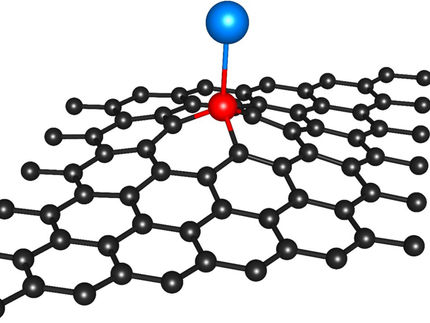New dual-atom catalyst shows promise to yield clean energy by artificial photosynthesis
Researchers from the US and China develop a dispersed catalyst featuring two atoms
Looking for new solutions to more efficiently harvest and store solar energy, scientists from the U.S. and China have synthesized a new, dual-atom catalyst to serve as a platform for artificial photosynthesis, the team reported today in the Proceedings of the National Academy of Sciences.

A structural characterization of a new iridium dinuclear heterogeneous catalyst reveals bright pairs of atoms. The new catalyst is regarded as an advance in efforts to produce and store clean energy through artificial photosynthesis.
PNAS
The team developed an iridium catalyst with only two active metal centers. Most significantly, experiments revealed the catalyst to be a well-defined structure, capable of serving as a productive platform for future research on solar fuel synthesis.
"Our research concerns the technology for direct solar energy storage," said Boston College Associate Professor of Chemistry Dunwei Wang, a lead author of the report. "It addresses the critical challenge that solar energy is intermittent. It does so by directly harvesting solar energy and storing the energy in chemical bonds, similar to how photosynthesis is performed but with higher efficiencies and lower cost."
Researchers have spent considerable time on single-atom catalysts (SACs) and rarely explored an "atomically dispersed catalyst" featuring two atoms. In a paper titled "Stable iridium dinuclear heterogeneous catalysts supported on metal-oxide substrate for solar water oxidation," the team reports synthesizing an iridium dinuclear heterogeneous catalyst in a facile photochemical way. The catalyst shows outstanding stability and high activity toward water oxidation, an essential process in natural and artificial photosynthesis.
Researchers focused on this aspect of catalysis encounter particular challenges in the development of heterogeneous catalysts, which are widely used in large-scale industrial chemical transformations. Most active heterogeneous catalysts are often poorly defined in their atomic structures, which makes it difficult to evaluate the detailed mechanisms at the molecular level.
The team was able to take advantage of new techniques in the evaluation of single-atom catalysts and develop a material platform to study important and complex reactions that would require more than one active site.
Wang said the team of researchers set out to determine "what the smallest active and most durable heterogeneous catalyst unit for water oxidation could be. Previously, researchers have asked this question and found the answer only in homogeneous catalysts, whose durability was poor. For the first time, we have a glimpse of the potential of heterogeneous catalysts in clean energy production and storage."
The team also performed X-ray experiments at Lawrence Berkeley National Laboratory's Advanced Light Source that helped to determine the structure of the iridium catalyst. They used two techniques: X-ray absorption fine structure (EXAFS) and X-ray Absorption Near Edge Structure (XANES) in their measurements. These experiments provide critical evidence to better understand the new catalyst.
Wang said the team was surprised by the simplicity and durability of the catalyst, combined with the high activity toward the desired reaction of water oxidation.
Wang said the next steps in the research include further optimization of the catalyst for practical use and an examination of areas where the catalyst can be applied to new chemical transformations.































































